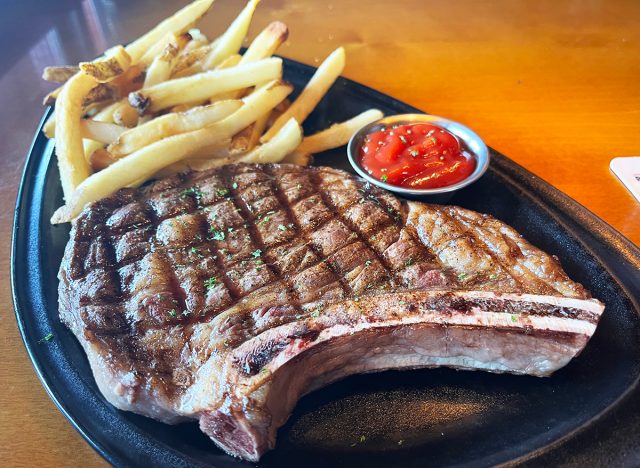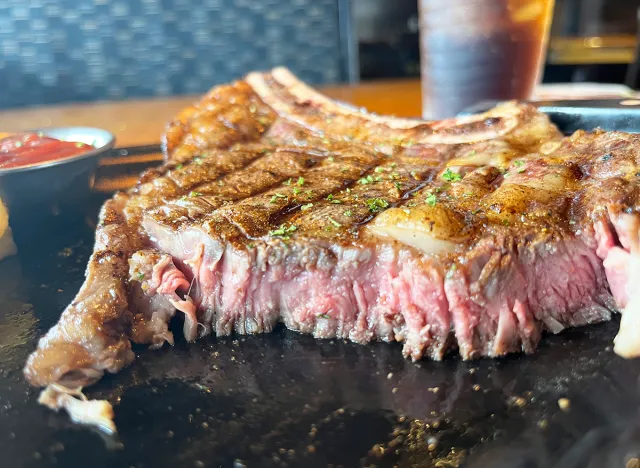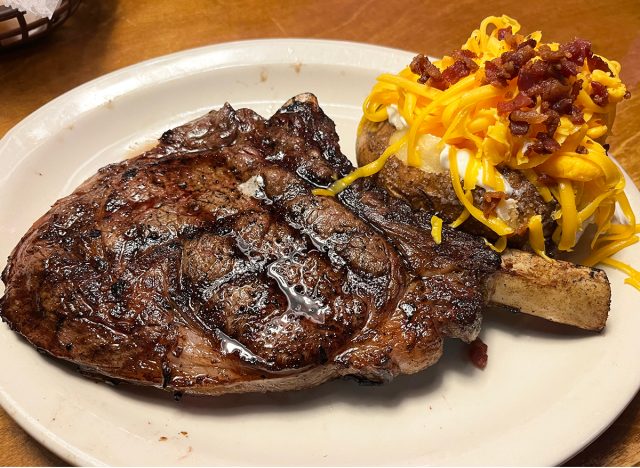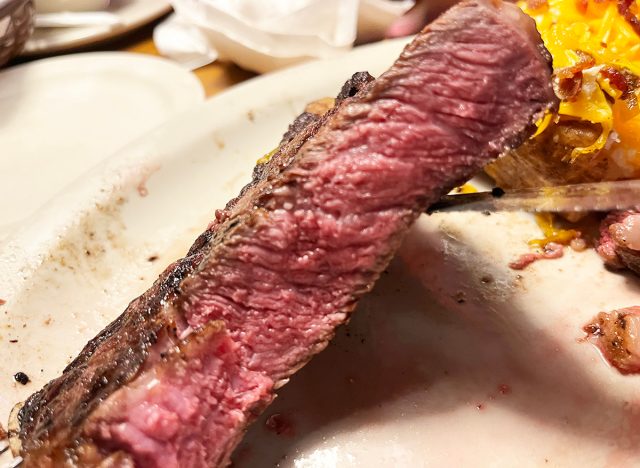The product recommendations in this post are recommendations by the writer and/or expert(s)
interviewed and do not contain affiliate links. Meaning: If you use these links to buy
something, we will not earn a commission.
The bone-in ribeye is one good-looking piece of meat. That’s a big reason why it’s featured so prominently in advertisements for America’s two leading steakhouse chains. Texas Roadhouse gives this stand-out steak a big closeup on the chain’s website, while Outback Steakhouse puts it on the front cover of its menus and on billboards along the nation’s highways.
If this were fashion and not food, you’d be talking about this glamorous cover model having “great bone structure.”
It’s a great-tasting steak, too, arguably one of the best. Cut from the cow’s rib section, the steak is lavishly marbled with fat, making it especially juicy and tender. And, according to Texas Roadhouse, grilling it with the rib bone attached gives it “extra flavor.”
It’s also a bit of a misnomer. Ask any real beef expert and they’ll tell you the bone-in ribeye is not actually a ribeye at all—it’s a rib steak. Ribeyes are technically boneless by definition. Still, “bone-in ribeye” has a really nice ring to it, so even beef-centric restaurants seem to just go with it.
Both major steakhouse chains take great pride in this particular steak, each serving USDA Choice cuts—the nation’s second-highest grade. This means they’re good quality meats, but far more affordable than the most profusely marbled, upper-crust cuts served at more posh steakhouses. Texas Roadhouse describes the bone-in ribeye as its “most expensive” and “most flavorful” steak, while Outback calls it a signature item, denoted by the kitschy boomerang logo on its menu.
But, which chain serves the most delicious rendition? I stopped by both restaurants this summer to see for myself.
Outback Steakhouse


Per Serving (18 ounces): 910 cal, 69 g fat (28 g Sat fat), 3110 g sodium, 3 g carbs (0 g fiber, 1 g sugar) 66 g protein
Outback’s bone-in ribeye is the runaway favorite of all seven steaks I tried recently at the 35-year-old Aussie-themed casual restaurant chain. I went back last week for another bite in order to better compare with its rival at the competing steakhouse. The 18-ounce cut cost $32.99 in Brooklyn, N.Y. Ordered medium rare, it weighed in at an even 15 ounces when it arrived at the table, according to my digital food scale.
The Look: Imposing. Uniformly checkered with grill marks and lightly sprinkled with herbs, the steak appeared quite muscular with a few noticeable pockets of fat in places. Roughly an inch or so thick, its outward color seemed more grayish than the same steak I ordered previously. The distinctive bone was hard to miss, situated right at the front of the plate. Inside it looked pink and moist with a light gray outline.
READ RELATED: Breastfeeding: Nature’s Gift Of Love, Bonding And Health


The Taste: Salty and nicely seasoned. Outback usually goes heavy with its seasonings, but thankfully offers a much lighter touch with this char-grilled steak. Its texture proved meltingly tender, requiring very little chewing. It’s a tasty steak, and the flavor of that seasoning is fairly consistent throughout. It also lingers on your tongue long after you leave, for better or worse.
After carving down to the bone, I noticed the underside still offered a lot of meat. Once I whittled and gnawed to the end, there was actually very little bone left. The skinny skeletal remains weighed only 1.4 ounces on my digital scale. As far as bone-in steaks go, this one was overwhelmingly meaty.
Texas Roadhouse


Per Serving (20 ounces): 1480 cal, 101 g fat (44 g sat fat) 1720 mg sodium, 20 g carbs (4 g fiber, 4 g sugar), 143 g protein
Admittedly, I had not dined at Texas Roadhouse before, and I was excited to experience what all the buzz was about. During a recent road trip, I stopped into the Hagerstown, Md., location to find a packed restaurant and a butcher case full of tantalizing cuts of beef, albeit not the bone-in ribeye that I came for. Thankfully, it was still available, just not on display. The 20-ounce cut cost $28.99. Ordered medium rare, it weighed in at 15.8 ounces when it arrived at the table, according to my scale.
The Look: Plump and super juicy. Its surface shimmered like it’s been swimming in butter all day. Meanwhile, the visible sear marks and overall charred look showcased its time on the grill. Compared to its counterpart at Outback, this ribeye appeared about a quarter-inch thicker and the rib bone noticeably stuck out of the meat like a handlebar. Inside the steak took on a luscious red color.


The Taste: Rich and succulent. On its website, Texas Roadhouse claims that each steak is “coated generous with our signature seasoning,” but based on this lightly seasoned sample, the restaurant appears to be far less generous than its rival. That’s not a bad thing. The modest treatment allowed more of the natural beefy flavor to shine through. Mouthwateringly tender, the juicy meat tasted saltier and ever more flavorful the closer I cut to the bone, which, once stripped bare, weighed about 3.3 ounces, roughly one-fifth of the total steak.
One thing that’s puzzling to me is how two steaks so similar in size and quality can vary so much statistically, according to their respective nutritional facts. Though purportedly just two ounces larger, the Texas Roadhouse ribeye somehow packs wildly more calories, more fat, and more than double the amount of protein than its competitor. The cooks in the back must be getting a real workout with those basting brushes. Meanwhile, the Outback steak comes loaded with nearly twice as much sodium, which probably speaks volumes about its seasoning levels.
The Verdict
I enjoyed both steaks and would order both again if I were dining at their respective restaurants. But based on these samples, the bone-in ribeye at Texas Roadhouse offers a bigger, better-looking, better-tasting, albeit probably not better-for-you, steak for a bit less money.
Put those extra four bucks toward a nice cold beer. After all that meat, you’re going to need it.









